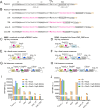Establishing a Malonyl-CoA Biosensor for the Two Model Cyanobacteria Synechocystis sp. PCC 6803 and Synechococcus elongatus PCC 7942
- PMID: 40588753
- PMCID: PMC12281612
- DOI: 10.1021/acssynbio.5c00320
Establishing a Malonyl-CoA Biosensor for the Two Model Cyanobacteria Synechocystis sp. PCC 6803 and Synechococcus elongatus PCC 7942
Abstract
Malonyl-CoA, produced by the first committed step of fatty acid biosynthesis, is a precursor for many valuable bioproducts, making it an important metabolic engineering target. Here, we establish a malonyl-CoA biosensor for the model cyanobacteria Synechocystis sp. PCC 6803 and Synechococcus elongatus PCC 7942. The developed biosensor utilizes FapR, a malonyl-CoA-regulated transcriptional repressor from Bacillus subtilis, and novel FapR-regulated and cyanobacteria-compatible hybrid promoters for expressing Yfp, the biosensor output reporter. A l-rhamnose-inducible promoter PrhaBAD, characterized in combination with ribosome binding sites of varied strengths, was evaluated for titratable FapR expression. Additionally, the placement and quantity of the FapR-recognized operator within the hybrid promoter was evaluated for its effect on biosensor performance. The optimal operator placement was found to differ for the biosensor variants that achieved maximum reporter expression in the two considered model cyanobacteria. Overall, this biosensor provides new opportunities for further development of cyanobacterial cell factories.
Keywords: biosensor; cyanobacteria; inducible promoter; malonyl-CoA; synthetic biology; transcriptional repressor.
Figures






Similar articles
-
Optimization of Malonyl Coenzyme A Biosensors in a Reconstituted Cell-Free System for Detecting Acetyl-CoA Carboxylase Activity.ACS Synth Biol. 2025 Aug 15;14(8):3245-3251. doi: 10.1021/acssynbio.5c00361. Epub 2025 Jul 31. ACS Synth Biol. 2025. PMID: 40742616 Free PMC article.
-
Engineered dynamic distribution of malonyl-CoA flux for improving polyketide biosynthesis in Komagataella phaffii.J Biotechnol. 2020 Aug 20;320:80-85. doi: 10.1016/j.jbiotec.2020.06.012. Epub 2020 Jun 20. J Biotechnol. 2020. PMID: 32574793
-
Photosynthetic sorbitol production in Synechococcus sp. PCC 7002 is enhanced by addressing phosphatase promiscuity, nutrient availability and Calvin cycle bottlenecks.Metab Eng. 2025 Sep;91:181-191. doi: 10.1016/j.ymben.2025.04.008. Epub 2025 May 2. Metab Eng. 2025. PMID: 40320001
-
Design and application of genetically-encoded malonyl-CoA biosensors for metabolic engineering of microbial cell factories.Metab Eng. 2017 Nov;44:253-264. doi: 10.1016/j.ymben.2017.10.011. Epub 2017 Oct 31. Metab Eng. 2017. PMID: 29097310 Review.
-
Fatty acid synthesis and utilization in gram-positive bacteria: insights from Bacillus subtilis.Microbiol Mol Biol Rev. 2025 Jun 25;89(2):e0006923. doi: 10.1128/mmbr.00069-23. Epub 2025 May 28. Microbiol Mol Biol Rev. 2025. PMID: 40434073 Review.
References
MeSH terms
Substances
Supplementary concepts
LinkOut - more resources
Full Text Sources

